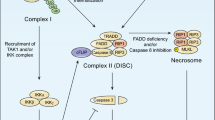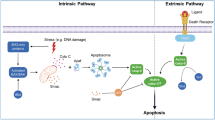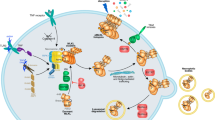Abstract
CD95 is a member of the death receptor family and is well-known to promote apoptosis. However, accumulating evidence indicates that in some context CD95 has not only the potential to induce apoptosis but also can trigger non-apoptotic signal leading to cell survival, proliferation, cancer growth and metastasis. Despite extensive investigations focused on alterations in the expression level of CD95 and associated signal molecules, very few studies, however, have investigated the effects of post-translational modifications such as glycosylation, phosphorylation, palmitoylation, nitrosylation and glutathionylation on CD95 function. Post-translational modifications of CD95 in mammalian systems are likely to play a more prominent role than anticipated in CD95 induced cell death. In this review we will focus on the alterations in CD95-mediated signaling caused by post-translational modifications of CD95.



Similar content being viewed by others
Abbreviations
- DR:
-
Death receptor
- TNF-R:
-
Tumor necrosis factor receptor
- CD95:
-
Cluster of differentiation 95
- FADD:
-
Fas-associated protein with death domain
- c-FLIP:
-
Cellular FLICE inhibitory protein
- DISC:
-
Death-inducing signaling complex
- DD:
-
Death domain
- DED:
-
Death effector domain
- MOMP:
-
Mitochondrial outer membrane permeabilisation
- Bid:
-
BH3 interacting-domain death agonist
- tBid:
-
Truncated Bid
- ERK:
-
Extracellular signal-regulated kinase
- NF-κB:
-
Nuclear factor κB
- CD95L:
-
CD95 ligand
- CRD:
-
Cysteine-rich domain
- NK:
-
Natural killer
- EGFR:
-
Epidermal growth factor receptor
- EGF:
-
Epidermal growth factor
- pEGFR:
-
Phosphorylated EGFR
- pSTAT3:
-
Phosphorylated STAT3
- SHP-1:
-
Src homology domain 2 (SH2)-containing tyrosine phosphatase-1
- NO:
-
Nitric oxide
References
Elmore S (2007) Apoptosis: a review of programmed cell death. Toxicol Pathol 35:495–516
Igney FH, Krammer PH (2002) Death and anti-death: tumour resistance to apoptosis. Nat Rev Cancer 2:277–288
Lavrik I, Golks A, Krammer PH (2005) Death receptor signaling. J Cell Sci 118:265–267
Gloire G, Charlier E, Piette J (2008) Regulation of CD95/APO-1/Fas-induced apoptosis by protein phosphatases. Biochem Pharmacol 76:1451–1458
Sessler T, Healy S, Samali A, Szegezdi E (2013) Structural determinants of DISC function: new insights into death receptor-mediated apoptosis signalling. Pharmacol Ther 140:186–199
Schulte M, Reiss K, Lettau M et al (2007) ADAM10 regulates FasL cell surface expression and modulates FasL-induced cytotoxicity and activation-induced cell death. Cell Death Differ 14:1040–1049
Kischkel FC, Hellbardt S, Behrmann I et al (1995) Cytotoxicity-dependent APO-1 (Fas/CD95)-associated proteins form a death-inducing signaling complex (DISC) with the receptor. EMBO J 14:5579–5588
Algeciras-Schimnich A, Griffith TS, Lynch DH, Paya CV (1999) Cell cycle-dependent regulation of FLIP levels and susceptibility to Fas-mediated apoptosis. J Immunol 162:5205–5211
Thome M, Schneider P, Hofmann K et al (1997) Viral FLICE-inhibitory proteins (FLIPs) prevent apoptosis induced by death receptors. Nature 386:517–521
Dickens LS, Boyd RS, Jukes-Jones R et al (2012) A death effector domain chain DISC model reveals a crucial role for caspase-8 chain assembly in mediating apoptotic cell death. Mol Cell 47:291–305
Schleich K, Warnken U, Fricker N et al (2012) Stoichiometry of the CD95 death-inducing signaling complex: experimental and modeling evidence for a death effector domain chain model. Mol Cell 47:306–319
Krammer PH, Arnold R, Lavrik IN (2007) Life and death in peripheral T cells. Nat Rev Immunol 7:532–542
Scaffidi C, Medema JP, Krammer PH, Peter ME (1997) FLICE is predominantly expressed as two functionally active isoforms, caspase-8/a and caspase-8/b. J Biol Chem 272:26953–26958
Golks A, Brenner D, Krammer PH, Lavrik IN (2006) The c-FLIP-NH2 terminus (p22-FLIP) induces NF-kappaB activation. J Exp Med 203:1295–1305
Hoffmann JC, Pappa A, Krammer PH, Lavrik IN (2009) A new C-terminal cleavage product of procaspase-8, p30, defines an alternative pathway of procaspase-8 activation. Mol Cell Biol 29:4431–4440
Golks A, Brenner D, Schmitz I et al (2006) The role of CAP3 in CD95 signaling: new insights into the mechanism of procaspase-8 activation. Cell Death Differ 13(3):489–498
Charlier E, Conde C, Zhang J et al (2010) SHIP-1 inhibits CD95/APO-1/Fas-induced apoptosis in primary T lymphocytes and T leukemic cells by promoting CD95 glycosylation independently of its phosphatase activity. Leukemia 24:821–832
Korsmeyer SJ, Wei MC, Saito M, Weiler S, Oh KJ, Schlesinger PH (2000) Pro-apoptotic cascade activates BID, which oligomerizes BAK or BAX into pores that result in the release of cytochrome c. Cell Death Differ 7:1166–1173
Lavrik IN, Golks A, Riess D, Bentele M, Eils R, Krammer PH (2007) Analysis of CD95 threshold signaling: triggering of CD95 (FAS/APO-1) at low concentrations primarily results in survival signaling. J Biol Chem 282:13664–13671
Hayden MS, Ghosh S (2012) NF-kappaB, the first quarter-century: remarkable progress and outstanding questions. Genes Dev 26:203–234
Cullen SP, Henry CM, Kearney CJ et al (2013) Fas/CD95-induced chemokines can serve as “find-me” signals for apoptotic cells. Mol Cell 49:1034–1048
Kennedy NJ, Kataoka T, Tschopp J, Budd RC (1999) Caspase activation is required for T cell proliferation. J Exp Med 190:1891–1896
Lavrik IN (2014) Systems biology of death receptor networks: live and let die. Cell Death Dis 5:e1259
Newton K, Harris AW, Bath ML, Smith KG, Strasser A (1998) A dominant interfering mutant of FADD/MORT1 enhances deletion of autoreactive thymocytes and inhibits proliferation of mature T lymphocytes. EMBO J 17:706–718
Barnhart BC, Legembre P, Pietras E, Bubici C, Franzoso G, Peter ME (2004) CD95 ligand induces motility and invasiveness of apoptosis-resistant tumor cells. EMBO J 23:3175–3185
Bentele M, Lavrik I, Ulrich M et al (2004) Mathematical modeling reveals threshold mechanism in CD95-induced apoptosis. J Cell Biol 166:839–851
Buchbinder JH, Pischel D, Sundmacher K, Flassig RJ, Lavrik IN (2018) Quantitative single cell analysis uncovers the life/death decision in CD95 network. PLoS Comput Biol 14:e1006368
Neumann L, Pforr C, Beaudouin J et al (2010) Dynamics within the CD95 death-inducing signaling complex decide life and death of cells. Mol Syst Biol 6:352
Siegmund D, Lang I, Wajant H (2017) Cell death-independent activities of the death receptors CD95, TRAILR1, and TRAILR2. FEBS J 284:1131–1159
Yuan K, Jing G, Chen J et al (2011) Calmodulin mediates Fas-induced FADD-independent survival signaling in pancreatic cancer cells via activation of Src-extracellular signal-regulated kinase (ERK). J Biol Chem 286:24776–24784
Lavrik IN, Krammer PH (2012) Regulation of CD95/Fas signaling at the DISC. Cell Death Differ 19:36–41
Feig C, Tchikov V, Schutze S, Peter ME (2007) Palmitoylation of CD95 facilitates formation of SDS-stable receptor aggregates that initiate apoptosis signaling. EMBO J 26:221–231
Jin Z, Li Y, Pitti R et al (2009) Cullin3-based polyubiquitination and p62-dependent aggregation of caspase-8 mediate extrinsic apoptosis signaling. Cell 137:721–735
Very N, Lefebvre T, El Yazidi-Belkoura I (2018) Drug resistance related to aberrant glycosylation in colorectal cancer. Oncotarget 9:1380–1402
Munkley J, Elliott DJ (2016) Hallmarks of glycosylation in cancer. Oncotarget 7:35478–35489
Ferreira JA, Magalhaes A, Gomes J et al (2017) Protein glycosylation in gastric and colorectal cancers: toward cancer detection and targeted therapeutics. Cancer Lett 387:32–45
Li Y, Yang X, Nguyen AH, Brockhausen I (2007) Requirement of N-glycosylation for the secretion of recombinant extracellular domain of human Fas in HeLa cells. Int J Biochem Cell Biol 39:1625–1636
Brockhausen I (2006) The role of galactosyltransferases in cell surface functions and in the immune system. Drug News Perspect 19:401–409
Peter ME, Hellbardt S, Schwartz-Albiez R et al (1995) Cell surface sialylation plays a role in modulating sensitivity towards APO-1-mediated apoptotic cell death. Cell Death Differ 2:163–171
Shatnyeva OM, Kubarenko AV, Weber CE et al (2011) Modulation of the CD95-induced apoptosis: the role of CD95 N-glycosylation. PLoS ONE 6:e19927
Garcia-Fuster MJ, Ferrer-Alcon M, Miralles A, Garcia-Sevilla JA (2004) Deglycosylation of Fas receptor and chronic morphine treatment up-regulate high molecular mass Fas aggregates in the rat brain. Eur J Pharmacol 496:63–69
Lichtenstein RG, Rabinovich GA (2013) Glycobiology of cell death: when glycans and lectins govern cell fate. Cell Death Differ 20:976–986
Keppler OT, Peter ME, Hinderlich S et al (1999) Differential sialylation of cell surface glycoconjugates in a human B lymphoma cell line regulates susceptibility for CD95 (APO-1/Fas)-mediated apoptosis and for infection by a lymphotropic virus. Glycobiology 9:557–569
Swindall AF, Bellis SL (2011) Sialylation of the Fas death receptor by ST6Gal-I provides protection against Fas-mediated apoptosis in colon carcinoma cells. J Biol Chem 286:22982–22990
Ta NL, Chakrabandhu K, Huault S, Hueber AO (2018) The tyrosine phosphorylated pro-survival form of Fas intensifies the EGF-induced signal in colorectal cancer cells through the nuclear EGFR/STAT3-mediated pathway. Sci Rep 8:12424
Chakrabandhu K, Hueber AO (2016) Fas versatile signaling and beyond: pivotal role of tyrosine phosphorylation in context-dependent signaling and diseases. Front Immunol 7:429
Corsini NS, Sancho-Martinez I, Laudenklos S et al (2009) The death receptor CD95 activates adult neural stem cells for working memory formation and brain repair. Cell Stem Cell 5:178–190
Kleber S, Sancho-Martinez I, Wiestler B et al (2008) Yes and PI3 K bind CD95 to signal invasion of glioblastoma. Cancer Cell 13:235–248
Letellier E, Kumar S, Sancho-Martinez I et al (2010) CD95-ligand on peripheral myeloid cells activates Syk kinase to trigger their recruitment to the inflammatory site. Immunity 32:240–252
Sancho-Martinez I, Martin-Villalba A (2009) Tyrosine phosphorylation and CD95: a FAScinating switch. Cell Cycle 8:838–842
Chakrabandhu K, Huault S, Durivault J et al (2016) An evolution-guided analysis reveals a multi-signaling regulation of fas by tyrosine phosphorylation and its implication in human cancers. PLoS Biol 14:e1002401
Su X, Zhou T, Wang Z, Yang P, Jope RS, Mountz JD (1995) Defective expression of hematopoietic cell protein tyrosine phosphatase (HCP) in lymphoid cells blocks Fas-mediated apoptosis. Immunity 2:353–362
Daigle I, Yousefi S, Colonna M, Green DR, Simon HU (2002) Death receptors bind SHP-1 and block cytokine-induced anti-apoptotic signaling in neutrophils. Nat Med 8:61–67
Duchesne C, Charland S, Asselin C, Nahmias C, Rivard N (2003) Negative regulation of beta-catenin signaling by tyrosine phosphatase SHP-1 in intestinal epithelial cells. J Biol Chem 278:14274–14283
Singer BB, Klaile E, Scheffrahn I et al (2005) CEACAM1 (CD66a) mediates delay of spontaneous and Fas ligand-induced apoptosis in granulocytes. Eur J Immunol 35:1949–1959
Eberle A, Reinehr R, Becker S, Haussinger D (2005) Fluorescence resonance energy transfer analysis of proapoptotic CD95-EGF receptor interactions in Huh7 cells. Hepatology 41:315–326
Eberle A, Reinehr R, Becker S, Keitel V, Haussinger D (2007) CD95 tyrosine phosphorylation is required for CD95 oligomerization. Apoptosis 12:719–729
Dietrich LE, Ungermann C (2004) On the mechanism of protein palmitoylation. EMBO Rep 5:1053–1057
Blaskovic S, Blanc M, van der Goot FG (2013) What does S-palmitoylation do to membrane proteins? FEBS J 280:2766–2774
Rossin A, Durivault J, Chakhtoura-Feghali T, Lounnas N, Gagnoux-Palacios L, Hueber AO (2015) Fas palmitoylation by the palmitoyl acyltransferase DHHC7 regulates Fas stability. Cell Death Differ 22:643–653
Chakrabandhu K, Herincs Z, Huault S et al (2007) Palmitoylation is required for efficient Fas cell death signaling. EMBO J 26:209–220
Ramaswamy M, Cleland SY, Cruz AC, Siegel RM (2009) Many checkpoints on the road to cell death: regulation of Fas-FasL interactions and Fas signaling in peripheral immune responses. Results Prob Cell Differ 49:17–47
Yurchenko M, Shlapatska LM, Sidorenko SP (2012) The multilevel regulation of CD95 signaling outcome. Exp Oncol 34:153–159
Mollinedo F, Gajate C (2006) Fas/CD95 death receptor and lipid rafts: new targets for apoptosis-directed cancer therapy. Drug Resist Updat 9:51–73
Pennarun B, Meijer A, de Vries EG, Kleibeuker JH, Kruyt F, de Jong S (2010) Playing the DISC: turning on TRAIL death receptor-mediated apoptosis in cancer. Biochim Biophys Acta 1805:123–140
Muppidi JR, Siegel RM (2004) Ligand-independent redistribution of Fas (CD95) into lipid rafts mediates clonotypic T cell death. Nat Immunol 5:182–189
Iyer AK, Azad N, Wang L, Rojanasakul Y (2008) Role of S-nitrosylation in apoptosis resistance and carcinogenesis. Nitric Oxide 19:146–151
Leon-Bollotte L, Subramaniam S, Cauvard O et al (2011) S-nitrosylation of the death receptor fas promotes fas ligand-mediated apoptosis in cancer cells. Gastroenterology 140:2009–2018 (2018.e2001-2004)
Dash PR, McCormick J, Thomson MJ, Johnstone AP, Cartwright JE, Whitley GS (2007) Fas ligand-induced apoptosis is regulated by nitric oxide through the inhibition of fas receptor clustering and the nitrosylation of protein kinase Cepsilon. Exp Cell Res 313:3421–3431
Janssen-Heininger YM, Aesif SW, van der Velden J et al (2010) Regulation of apoptosis through cysteine oxidation: implications for fibrotic lung disease. Ann N Y Acad Sci 1203:23–28
Anathy V, Aesif SW, Guala AS et al (2009) Redox amplification of apoptosis by caspase-dependent cleavage of glutaredoxin 1 and S-glutathionylation of Fas. J Cell Biol 184:241–252
Fernandes AP, Holmgren A (2004) Glutaredoxins: glutathione-dependent redox enzymes with functions far beyond a simple thioredoxin backup system. Antioxid Redox Signal 6:63–74
O’ Reilly LA, Tai L, Lee L et al (2009) Membrane-bound Fas ligand only is essential for Fas-induced apoptosis. Nature 461:659–663
Acknowledgements
We acknowledge Volkswagen Foundation (VW 90315), Wilhelm Sander-Stiftung (2017.008.01), Center of dynamic systems (CDS), funded by the EU-programme ERDF (European Regional Development Fund) and DFG (LA 2386) for supporting our work.
Author information
Authors and Affiliations
Corresponding author
Ethics declarations
Conflict of interest
The authors declare no conflict of interest.
Additional information
Publisher's Note
Springer Nature remains neutral with regard to jurisdictional claims in published maps and institutional affiliations.
Rights and permissions
About this article
Cite this article
Seyrek, K., Lavrik, I.N. Modulation of CD95-mediated signaling by post-translational modifications: towards understanding CD95 signaling networks. Apoptosis 24, 385–394 (2019). https://doi.org/10.1007/s10495-019-01540-0
Published:
Issue Date:
DOI: https://doi.org/10.1007/s10495-019-01540-0




